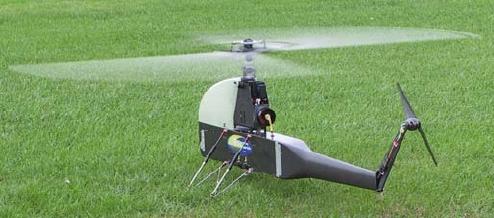Naval Research Lab Spider
The Spider (Scientific Payload Insertion Device Electric Rotor) UAV was developed by the Naval Research Laboratory (NRL) in 2004/2005 as a very low-cost (to be economically expendable) autonomous unmanned mini-helicopter for the delivery of small sensor payloads to inaccessible areas. Flight testing of a prototype vehicle began in June 2004.
 |
| Photo: NRL |
| Spider |
The Spider is powered by an electric motor, and is controlled by an autopilot with a neural network adaptive flight control system. It can complete fully autonomous missions including vertical take-off, flight to the designated target using GPS, hover over a precise location, and return to an automatic landing. The UAV can carry a 1.8 kg (4 lb) payload of scientific or countermeasures devices in the fuselage between the landing skids. Spider's maximum endurance is about 30 minutes, and it is also equipped with an Iridium satellite data link for beyond RF line-of-sight operations.
Specifications
Note: Data given by several sources show slight variations. Figures given below may therefore be inaccurate!
Data for Spider:
| Length | ? |
| Rotor diameter | ? |
| Weight | 18 kg (40 lb) |
| Speed | 80 km/h (50 mph) |
| Ceiling | ? |
| Endurance | 30 min. |
| Propulsion | Electric motor |
Main Sources
[1] NRL UAV Fact Sheets
[2] NRL Develops Fully Autonomous Compact Electric
Helicopter, NRL Press Release, 6 September 2005
Back to Directory of U.S. Military Rockets and Missiles, Appendix 4
Last Updated: 7 February 2006